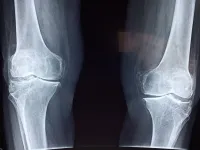(Press-News.org) Breathing in secondhand cigarette smoke may leave you more vulnerable to heart failure, a condition where the heart isn't pumping as well as it should and has a hard time meeting the body's needs, according to a study being presented at the American College of Cardiology's 70th Annual Scientific Session.
The data showed that nonsmokers with recent exposure to secondhand smoke had a 35% increased odds of developing heart failure compared with those who hadn't been around tobacco. The association between tobacco exposure and heart failure remained, even after controlling for other factors known to heighten the risk for heart failure such as a history of other heart conditions, high cholesterol and diabetes.
While previous studies have demonstrated the impact of secondhand smoke exposure on people with existing heart failure--for example, on outcomes such as mortality, quality of life and exercise tolerance--this is the first to show an association between tobacco exposure and developing heart failure.
"It adds to overwhelming evidence that secondhand smoke is harmful," said Travis Skipina, MD, resident physician in the department of internal medicine at the Wake Forest School of Medicine and the study's lead author. "[Secondhand smoke] has been associated with stroke and heart attacks, but what really hadn't been reported before was its association with heart failure, which is a very debilitating and costly disease."
The analysis included 11,219 participants from the U.S. Third National Health and Nutrition Examination (NHANES) survey who reported being nonsmokers. Participants in this NHANES cohort were followed from 1988-1994. They were 48 years old on average, just over half were women (55.9%) and most (70.5%) were white. Nearly 1 out of 5 had evidence of secondhand smoke exposure.
The association of secondhand smoke and heart failure was stronger in men (compared with women) and among those who had reported a prior heart attack or stroke. The findings were similar across other subgroups, including different ethnic/racial groups and individuals with obesity and diabetes.
"For whatever reason, in males, the impact of secondhand smoke appears to be more likely to put them at risk of heart failure," Skipina said. "Males, in general, tend to get [cardiovascular] disease at a younger age and overall, they were younger, so that may be why they were predisposed."
Skipina and his colleagues defined secondhand smoke as having a serum cotinine level ?1ng/mL, the recommended cutoff for heavy exposure used by the Centers for Disease Control and Prevention. Serum cotinine is a metabolite of nicotine that is used to measure levels of smoke exposure and usually signifies that someone has been breathing in tobacco smoke in the environment within the last one to two days (half-life of 18-20 hours). To assess dose-response, cut-off points of serum cotinine ?3ng/mL and ?6ng/mL were also used. Whether someone had heart failure was defined as answering "yes" to the survey question, "Has a doctor ever told you that you have congestive heart failure?"
Because this is a cross sectional study, it only gives a snapshot in time and cannot establish cause and effect. It is also based on an older data set. Still, Skipina said the association of secondhand smoke exposure with prevalent heart failure persisted even in a contemporary comparison of 3,796 participants followed between 2003-2006, which comes after many public smoking efforts had taken effect.
"Even with the decrease in background secondhand smoke exposure, it was still found to have a positive association with heart failure," Skipina said. "Active and secondhand smoke induces a proinflammatory state, and higher levels of inflammation affects all body tissues, and it can lead to maladaptive changes in the heart structure and damage to the blood vessels."
More research is needed to unravel the link between secondhand smoke, especially with the advent of vaping, and heart failure. Still, Skipina said the findings are a reminder for people who have heart failure or are at high risk of developing it that "they should be aware that secondhand smoke exposure may play a role." He notes this is even more relevant for lower income communities and countries where rates of tobacco use are often much higher and stringent health policies are less likely to be in place and/or enforced.
INFORMATION:
The study will be simultaneously published online in the journal, Nicotine & Tobacco Research.
Skipina will present the study, "Secondhand Smoke is Associated with Prevalent Heart Failure: The Third National Health and Nutrition Examination Survey," on Sunday, May 16, at 9:45 a.m. ET / 13:45 UTC.
ACC.21 will take place May 15-17 virtually, bringing together cardiologists and cardiovascular specialists from around the world to share the newest discoveries in treatment and prevention. Follow @ACCinTouch, @ACCMediaCenter and #ACC21 for the latest news from the meeting.
The American College of Cardiology envisions a world where innovation and knowledge optimize cardiovascular care and outcomes. As the professional home for the entire cardiovascular care team, the mission of the College and its 54,000 members is to transform cardiovascular care and to improve heart health. The ACC bestows credentials upon cardiovascular professionals who meet stringent qualifications and leads in the formation of health policy, standards and guidelines. The College also provides professional medical education, disseminates cardiovascular research through its world-renowned JACC Journals, operates national registries to measure and improve care, and offers cardiovascular accreditation to hospitals and institutions. For more, visit ACC.org.
Media Contacts
Nicole Napoli
202-669-1465
nnapoli@acc.org
Thy-Ann Nguyen
703-479-3642
thyann.nguyen@curastrategies.com
People who clock six to seven hours of sleep a night had the lowest chance of dying from a heart attack or stroke when compared with those who got less or more sleep, according to a study being presented at the American College of Cardiology's 70th Annual Scientific Session. This trend remained true even after the research team accounted for other known conditions or risk factors for heart disease or stroke.
The study, according to researchers, is the first to explore the association between baseline cardiovascular risk and duration of sleep and adds to mounting evidence that sleep--similar to diet, smoking and exercise--may play a defining role in someone's cardiovascular ...
Individuals living with a spouse with heart disease were more than twice as likely to have heart disease themselves, according to a study being presented at the American College of Cardiology's 70th Annual Scientific Session.
Researchers surveyed more than 5,000 heterosexual couples over the age of 45 living in seven regions of China from 2014-2016. Participants provided information about their personal health history and that of their spouse, including details about risk factors such as body mass index and blood pressure; lifestyle factors such as physical activity, smoking and alcohol use; and socioeconomic factors. For the study, a history of cardiovascular disease was defined as experiencing ...
Young Black women show a high prevalence of obesity, elevated blood pressure and other lifestyle-related factors that may put them on a trajectory to develop heart disease at a young age, according to a study presented at the American College of Cardiology's 70th Annual Scientific Session.
While previous research has drawn attention to the burden of heart disease among Black women, the new study is unique in its focus on examining the age at which heart disease risk factors emerge in this population in a community setting. The researchers found high rates of lifestyle-linked risk factors among Black women as early as their 20s and 30s.
"Young people should be the healthiest members of our population with normal body weight and normal blood pressure," ...
Hamilton, ON (May 5, 2021) - Schools and child care centres should train staff on food allergies and have epinephrine available to treat anaphylaxis, but new guidelines do not recommend food bans.
The recommendations come from an international team, led by McMaster University, which has developed practice guidelines for the prevention and management of allergic reactions to food at child care centres and schools. The guidelines were published today in the Journal of Allergy and Clinical Immunology.
"The management of food allergy is a sensitive topic," said Susan Waserman, ...
LEXINGTON, Ky. (May 5, 2021) - Collaborative research between the University of Kentucky (UK) and University of Southern California (USC) suggests that a noninvasive neuroimaging technique may index early-stage blood-brain barrier (BBB) dysfunction associated with small vessel disease (SVD). Cerebral SVD is the most common cause of vascular cognitive impairment, with a significant proportion of cases going on to develop dementia. BBB dysfunction represents a promising early marker of SVD because the BBB regulates a number of important metabolic functions, including clearance of toxic brain substances.
Advanced ...
Current guidelines for managing osteoporosis specifically call out hip or spine fractures for increasing the risk for subsequent bone breaks. But a new UCLA-led study suggests that fractures in the arm, wrist, leg and other parts of the body should also set off alarm bells.
A fracture, no matter the location, indicates a general tendency to break a bone in the future at a different location, said Dr. Carolyn Crandall, the study's lead author and a professor of medicine at the David Geffen School of Medicine at UCLA.
"Current clinical guidelines have only been emphasizing hip and spine fractures, but our findings challenge that viewpoint," Crandall said. "By not paying attention to which types of fractures increase the risk of future fractures, we are missing the opportunity to ...
Research led by the Garvan Institute of Medical Research has for the first time mapped the unique genetic profile of the skeleton's 'master regulator' cells, known as osteocytes.
The study published today in Nature Communications outlines the genes that are switched on or off in osteocytes, a type of bone cell that controls how other types of cells make or break down parts of the skeleton to maintain strong and healthy bones.
"This new information provides a kind of genetic shortlist we can look to when diagnosing bone diseases that have a genetic component," says the study's first author Dr Scott Youlten, Research Officer in the Bone Biology ...
Mammals see with their eyes, hear with their ears and smell with their nose. But which sense or organ allows them to orient themselves on their migrations, which sometimes go far beyond their local foraging areas and therefore require an extended ability to navigate? Scientific experiments led by the Leibniz Institute for Zoo and Wildlife Research (Leibniz-IZW), published together with Prof. Richard A. Holland (Bangor University, UK) and Dr. Gunārs P?tersons (Latvia University of Life Sciences and Technologies) now show that the cornea of the eyes is the location of such an important sense in migrating bats. If the cornea is anaesthetised, the otherwise ...
A study involving researchers at Karolinska Institutet and Gothenburg University in Sweden has found that low levels of a protein called PDGFRb are associated with particularly good results of radiotherapy in women with early-stage breast cancer. The study, which is published in the journal Clinical Cancer Research, also suggests that the efficacy of radiotherapy can be improved with drugs that block this protein.
Some 900 women in Sweden are diagnosed with DCIS (ductalcarcinoma in situ), the earliest possible form of invasive breast cancer. Standard treatment is ...
MINNEAPOLIS - Chronic kidney disease is when a person's kidneys progressively lose their ability to filter waste from the blood and eliminate fluids. Now a new study has found that people with reduced kidney function may have an increased risk of developing dementia. The study is published in the May 5, 2021, online issue of Neurology®, the medical journal of the American Academy of Neurology.
Chronic kidney disease affects approximately 15% of adults in the United States and it is more common as people age. However, since many people don't experience ...

